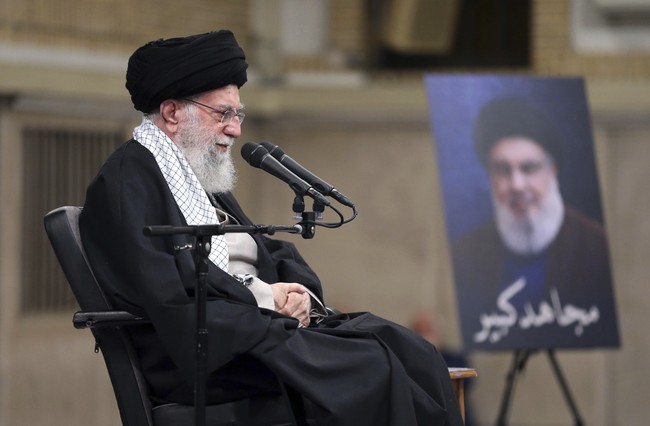
This weekend, the US and Iran will hold their first semi-direct talks in years, despite the previous insistence of Ayatollah Ali Khamenei in barring such talks. What changed? First, the Iranian security situation has degraded rapidly over the last few months, thanks to their stupidity in attacking Israel directly as well as indirectly through their proxies. That has left the mullahs more exposed than ever before in their 46-year run as theocratic tyrants in Iran.
That’s not the only reason, the New York Times reports today. The Iranians may have finally realized that Donald Trump returned to office with the goal of settling scores — and that a squadron of B-2 Stealth bombers in Diego Garcia aren’t waiting around just for show. The government pressured Khamenei to end the ban and allow them to try to talk their way out of destruction:
Mr. Khamenei had publicly and repeatedly banned engaging with Washington, calling it unwise and idiotic. The senior officials, in an unusual coordinated effort, urged him to change course, said the two officials, who asked not to be named to discuss sensitive issues.
The message to Mr. Khamenei was blunt: Allow Tehran to negotiate with Washington, even directly if necessary, because otherwise the Islamic Republic’s rule could be toppled.
The country was already dealing with an economy in shambles, a currency plunging against the dollar and shortages of gas, electricity and water. The threat of war with the United States and Israel was extremely serious, the officials warned. If Iran refused talks or if the negotiations failed, the officials told Mr. Khamenei, military strikes on Iran’s two main nuclear sites, Natanz and Fordow, would be inevitable.
Iran would then be forced to retaliate, risking a wider war, a scenario that could further damage the economy and spark domestic unrest, including protests and strikes, the officials said. Fighting on two fronts posed an existential threat to the regime, they added.
And that would be the point. But it’s worth recalling how Iran came to such a pass in the first place.
On October 6, 2023, Iran’s encirclement strategy via its three main proxy armies — Hezbollah, Hamas, and the Houthis — was still relatively strong. More importantly, Hezbollah propped up Bashar al-Assad in Syria, where Iran had significant military assets, especially in anti-aircraft radar and materiel. Hezbollah had Israel pinned down in the north and Hamas in the south, and the Houthis were a threat to the region thanks to Iranian arms and military assistance.
Then Hamas launched its “Al-Aqsa Flood Operation” on October 7, and rather than read the significance of the Israeli response, Iran chose to double down. They allowed Hezbollah to launch a war in the north, which turned out to be the fatal error of the entire Iranian mullahcracy’s run. Khamenei vastly underestimated Israeli capacity and American support, and then doubled down with direct attacks for the first time on Israel. At each stage, Iran lost both in nominal terms and in internal credibility.
And then Israel finally took Hezbollah on directly, with utterly calamitous results for Tehran. In a single afternoon, Israel wiped out most of Hezbollah’s command structure, and then spent the next few weeks decimating its other assets. Because of that, Hezbollah could no longer prop up Assad, who had to flee for his life just a few weeks afterward — and Iran lost its defensive position in a region where most countries have every reason to crush its theocratic tyrants.
And then Donald Trump got elected, and sent that squadron of B-2s to Diego Garcia after taking office. He also warned that US forces would retaliate against both the Iranian-backed Houthis as well as Iran itself if any more attacks on Red Sea shipping took place. Trump also ordered full-scale attacks on Houthi assets in Yemen rather than the one-off retaliatory strikes Joe Biden had ordered, to the point where Iran finally was forced to pull its support for the Houthis and rethink their entire regional strategy. The B-2s only have two real potential targets: Yemen and Iran. And it’s clear that the US doesn’t need that stealth technology to deal with the Houthis, who are about to blink out of existence even by Iranian estimations.
This is how power works in the world. The Israelis understand that, the Iranians understand it, and now the US has an administration that understands it as well. The world is not made safer by powerful nations ignoring threats to its security and the security of its allies, and it is certainly not made safer in humiliating retreats under fire by 7th-century terrorist goons in Kabul. Trump made that point clear when he ordered the strike on Qassem Suleimani five years ago, a lesson the Iranians still clearly recall. Trump is not afraid to use power to change the threat horizon, and the Iranians are in a far weaker position than when Suleimani hit room temperature in 2020.
Perhaps the most remarkable part of this story is that it’s on the pages of the New York Times. Kudos to them for the coverage, but in truth there is no spinning this story. The Iranians are talking because the Israelis stripped them of their forward defenses, their population is chafing under their economic disasters, and they know Trump is serious about ending the Iranian nuclear threat by any means necessary. The Iranian appeasers are gone, and the serious adults have taken over policy again — and not a moment too soon.
















